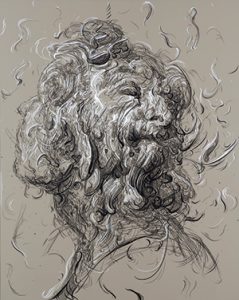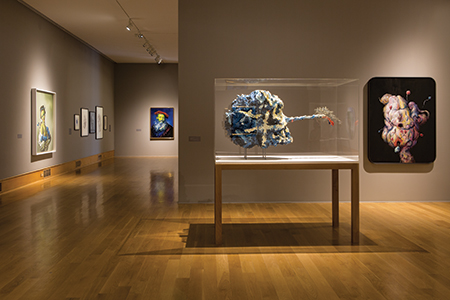Above: In 2016, the Des Moines Art Center presented British artist Glenn Brown’s first solo exhibition in the United States. The Art Center now owns Brown’s “Swing Time” (see the story on the following page). Photographer: Rick Lozier.
Writer: Vicki L. Ingham
However rich an art museum’s collection is, the chance to add breadth or depth with a new acquisition brings a gleam to a curator’s eye. A survey of five art museums across Iowa shows that recent acquisitions include works of national and international significance, offering Iowans fresh opportunities to see world-class art close to home.

A New Direction
“Swing Time” by Glenn Brown
Des Moines Art Center
The Des Moines Art Center is in the enviable position of having acquired not one but three of the artists on its extensive wish list in 2016. Although director Jeff Fleming is pleased about all of them, the most exciting in terms of international significance is the India ink and acrylic drawing “Swing Time” by British artist Glenn Brown.
Born in 1966, Brown is best known for paintings that appropriate images and elements from Western art history, which he distorts, manipulates and combines to make something new. “He’s responding to the history of Western art and reconfiguring it,” Fleming says. Brown is also known for his jaw-dropping technical mastery. In his paintings, as opposed to the “Swing Time” drawing, what appears to be thick, impasto brushwork is actually a trompe l’oeil effect—the surfaces of his paintings are perfectly flat and glass-smooth.
Brown has shown his paintings, drawings and sculptures in more than 125 international group and solo shows. In 2016, the Des Moines Art Center presented Brown’s first solo museum exhibition in the United States. “Swing Time” was the signature image for the exhibit, and Fleming notes that “it was the most significant work in a new direction for the artist. It presents a new linear direction as opposed to the trompe l’oeil [of his paintings].” The work combines two faces, “very much like Janus in Roman mythology. One looks to the past, one to the future,” Fleming says.
The title refers to the 1936 movie starring Fred Astaire and Ginger Rogers, according to Steven Matijcio, curator at the Contemporary Arts Center in Cincinnati, which hosted the 2016 solo exhibit following the Art Center. Although the box-office hit was considered the duo’s best dance musical, it also marked the beginning of the end of the team’s popularity and magical creativity. From that bit of movie history, Brown’s meditations led to the idea of standing on the cusp of change, captured with the image of forward- and backward-looking faces.
Adding the drawing to the Des Moines Art Center’s permanent collection of more than 5,000 works of art dovetails perfectly with the institution’s collecting philosophy, Fleming says: “Our philosophy is to collect artists of our time, modern and contemporary, mostly living artists.” The Art Center strives “to get a signature work that exemplifies that artist’s career,” he adds.
Brown is an internationally recognized artist who is “making contributions to the cultural record in terms of looking at the history of Western civilization and updating painting,” Fleming says.
Fun fact: Brown pulls images from the internet, magazines, art history books, and other secondary sources and uses Photoshop to manipulate and change them to produce the image he ultimately paints.

Life In the Jim Crow South
“Department Store, Mobile, Alabama” by Gordon Parks
Faulconer Gallery, Grinnell College
Although education is a component of any museum’s purpose, for the Faulconer Gallery at Grinnell College, it’s paramount.
“We are always on the lookout for things we know will be actively used in teaching,” says Lesley Wright, the gallery’s director.
The target audience goes beyond art students to include students of history, political science, gender studies, languages and any other course that can make creative use of visual material.
The acquisition of “Department Store, Mobile, Alabama” by renowned photographer Gordon Parks was a particularly exciting addition precisely because it offers so many avenues for study. Parks not only was the first African-American staff photographer and writer at Life magazine but also one of the most important photographers of the 20th century. Over the course of his long career, he captured iconic images of figures such as Malcom X, Stokely Carmichael and Muhammad Ali, as well as the everyday lives of ordinary African-Americans. Documenting rural poverty, urban life and the civil rights movement, he used his camera to promote empathy and to advocate for social and economic reforms.
Daniel Strong, the Faulconer’s associate curator, first saw “Department Store, Mobile, Alabama” on the invitation to a 2013 exhibition in San Francisco. “I said immediately,
‘I want this picture,’ so I kept the invitation on my desk. Lo and behold, a gallery I’d been doing business with in Toronto on another project became the representatives of the Gordon Parks Foundation, so all of a sudden this photograph became available to us through a freak coincidence.” It was the first of five photographs by Parks to enter the college’s permanent collection, and it’s Strong’s favorite because of the quality of the image—and because of the back story.
Parks shot the picture on an assignment for Life in 1956, focusing on a family in Mobile to explore the impact of Jim Crow laws on African-Americans in the South. It wasn’t among the 20 images that were published, however, and until 2012, it was believed to have been lost, along with the bulk of the film from that shoot. Then the Gordon Parks Foundation found a package of about 70 color transparencies wrapped in paper and labeled “Segregation Series.” The foundation owns the rights to Parks’ work and has printed selected images in limited editions. “This image is now considered one of the highlights of the whole series,” Strong says.
Although it’s titled “Department Store,” the photograph depicts Joanne Wilson and her niece outside the Saenger Theater in Mobile. In a 2013 interview with The New York Times, Wilson explained that her niece had smelled popcorn and wanted some, but when they arrived at the theater door, Wilson was determined not to take her niece through the “colored” entrance. “All I could think was where I could go to get her popcorn,” she said.
“The appeal for me,” says Strong, “is that when we think of civil rights history, we think of demonstrations. We don’t think of everyday people like this, people going about their lives under Jim Crow segregation laws.”
The fact that Wilson and her niece are dressed in their Sunday best for the trip downtown reflects the customs of the time—in 1956 everyone dressed up to go downtown—but it also conveys dignity and self-respect. “As she said, she didn’t want to be mistaken for a servant when she went out,” Strong adds. The fact that the photo is in color not only distinguishes it from other civil rights photography, which was more often in black and white, but also gives it a contemporary feeling, collapsing the illusion of segregation belonging to the distant past.
Parks’ work perfectly expresses the collecting philosophy of the Faulconer. “There is a strong social justice aspect to what we collect,” Wright says.
Fun fact: Born in Fort Scott, Kansas, in 1912, Gordon Parks taught himself photography, using a camera he bought from a pawnshop. In addition to his achievements as a photojournalist, Parks was a noted fashion photographer, musician, novelist and film director whose credits include the 1971 movie “Shaft,” one of the first (and most popular) entries in the “blaxploitation” genre.

Painted and welded steel, 43 x 25 x 75 inches
Keep On Truckin’
“Bend in the Road” by John Himmelfarb
Sioux City Art Center
The soaring glass-walled atrium of the Sioux City Art Center can be a formidable space to fill, but director Al Harris-Fernandez thought John Himmelfarb’s sculpture “Bend in the Road” would be up to the challenge. “I was really excited when I saw his sculptural works,” says Harris-Fernandez, “and I thought the trucks have a sense of humor and a certain sensibility that would appeal to our visitors here.”
The Sioux City Art Center focuses on artists of the Upper Midwest and already had prints and paintings by Himmelfarb in its permanent collection of about 1,100 objects. The institution is committed to collecting individual artists in some depth, so adding an example of his sculpture nicely rounds out its holdings of the Chicago artist’s work.
Himmelfarb was born in 1946 to artists Samuel and Eleanor Gorecki Himmelfarb and grew up in a house his parents designed, overlooking the DuPage River. After graduating from Harvard University in 1968, he embarked on a long and dizzyingly prolific career, making prints, paintings, murals and sculptures in a wide variety of mediums and category-defying styles. His prints and paintings, boldly colorful, relentlessly energetic and often playful, suggest the influence of abstract expressionism, pop art, Chicago imagism, graffiti art and calligraphy.
The sculptures from the last eight years range from abstract metal compositions to salvaged vintage trucks piled high with found materials. His work has been featured in more than 70 solo exhibitions and is in more than 50 public collections across the United States as well as at the Bibliothèque Nationale in Paris and the British Museum in London.
Harris-Fernandez believes that one role of the Art Center is to engage visitors with art that, through its popular appeal, helps create community. “If you’re in the atrium and you see a family with kids walk in, they will immediately run over to this sculpture,” he says.
The bright yellow welded-steel piece works on a variety of levels, he adds: “It’s humorous—it looks like a cartoon version of a truck—but it’s also interesting as a sculpture, with … pieces of steel welded together to make an interesting object.”
Trucks have appeared from time to time in Himmelfarb’s prints and drawings since the 1970s, but in 2003 he began focusing on the mechanical workhorse of modern life in a more intentional way. Harris-Fernandez notes, “Himmelfarb says he’s not doing trucks; he just has trucks as a subject in order to make art.”
Fun fact: Himmelfarb first exhibited at the Sioux City Art Center in 1997. His mother, Eleanor, exhibited her nature-inspired abstract paintings there in 2002—when she was 92.

“Primary Vision” (2011)
Hand-built glazed ceramics on stainless steel tables; 71 x 38 x 43 inches and 71 x 43 x 47 inches
Making Conversation
“Primary Vision” by Jun Kaneko
Cedar Rapids Museum of Art
When the Cedar Rapids Museum of Art undertook a capital campaign in 2012-2014, the project presented an unusual opportunity to acquire a significant piece of public art as part of the dramatic transformation of the Third Avenue entrance with a new public plaza between the building and the street. Along with gardens and seating areas, the new plaza showcases the museum’s most exciting recent acquisition: “Primary Vision” by Omaha-based ceramicist Jun Kaneko.
“We wanted to have a really magnificent work of art for this program,” says director Sean Ulmer. Kaneko has installed sculptures in urban settings all over the world and is known for an uncanny ability to visualize how a piece will work in a given environment, even though he has never visited it personally. For Cedar Rapids, the artist chose a pair of 6-foot-tall heads from his “Heads” series.
One reason museum officials were attracted to Kaneko’s work is their desire to build the museum’s ceramics collection. “The Midwest and Iowa are actually a hotbed of great potters,” says Ulmer, “and we realized we did not represent that very well. So when we were looking for a statement piece for the front of the building, it occurred to us we might be able to find a great potter to make that piece, and that moved Jun right up to the top.”
Described by Art & Antiques magazine as “one of the key figures in the American contemporary ceramics movement,” Kaneko was born in Japan in 1942 and came to the United States in 1963 to study painting. He soon shifted his focus to ceramics and went on to teach at the Rhode Island School of Design and the Cranbrook Academy of Art. In 1986, he moved to Omaha, his wife’s hometown, and opened a studio where he has produced more than 50 public art pieces, including “Dangos” in downtown Des Moines. His large-scale installations occupy public spaces in Council Bluffs, Kansas City, Boston, Lincoln, Shanghai and Japan. His paintings, drawings and sculptures are in more than 70 museum collections.
In a video interview with Drake University’s Lenore Metrick-Chen, Kaneko said he sees his pieces as alive and in conversation with one another and with their environment. That notion of conversation and the influence of the surrounding space led to a surprise, last-minute change in the installation of “Primary Vision.” When the sculpture was exhibited at the Kennedy Center, the heads faced each other, which is how Ulmer imagined they would be placed outside the museum.
“At the time of installation, however, one of [Kaneko’s] assistants came to help us install it on the site,” says Ulmer, “and he said, ‘No, Jun wants them facing out to the public.’ ”
The repositioning creates a conversation between the sculpture and anyone passing by or coming to the museum. It also reflects Kaneko’s attention to site: The ceramic heads gaze across the street to Green Square, the oldest public space in Cedar Rapids, and the new library beyond. “They’re much more engaging this way,” Ulmer says “It makes perfect sense on different levels, in the context in which they’re placed and with how people interact with the museum in general.”
Fun fact: In addition to producing drawings, paintings and sculpture, Kaneko has designed the sets and costumes for three operas: “Madama Butterfly” (2006), “Fidelio” (2008) and “The Magic Flute” (2014).

Face of a Community
“Portrait of Maquoketa” by Rose Frantzen
Figge Art Museum, Davenport
“Portrait of Maquoketa” started as an idea for a group exhibition and turned into a love letter to a town and a catalyst for community revival. When the Figge Art Museum in Davenport exhibited the installation in 2012-2013, the reaction was so favorable that members of the community joined the board members and one of the artist’s patrons to buy it, raising two-thirds of the purchase price. The remaining third came from the museum’s acquisition fund.
“There was so much enthusiasm for getting it into the collection,” says director Tim Schiffer. “It was unusual in that groundswell of enthusiasm. None of us wanted to see the portraits broken up.”
The project began in July 2005, when Maquoketa native Rose Frantzen rented an empty storefront downtown and invited anyone who was willing to sit for four hours to come and have his or her portrait painted. Trained in classical realism and the alla prima (direct painting) technique, she painted 12-inch-square portraits in a loose, wet-into-wet style reminiscent of the bold, confident brushwork of John Singer Sargent. By September 2005, she had completed 70 portraits, which appeared in a group exhibition at the Dubuque Museum of Art. She kept painting, and by July 2006 she had finished 110 more.
In 2009-2010, all 180 portraits were included in an exhibition at the Smithsonian National Portrait Gallery. When the Figge expressed interest in showing the portraits, Frantzen continued to develop the work. From the beginning, she’d had the idea of incorporating a landscape. With the help of her artist husband, Chuck Morris, she designed an installation of hanging panels with portraits stacked on one side of each panel and a slice of landscape on the other. The panels hang so that from one specific spot, all of the slices coalesce into a panoramic, golden vista of rolling fields and a cloud-studded sky, with the town tucked among trees in the distance.
The installation includes a soundtrack created by Frantzen’s brother, John, a well-known composer. When viewers look at the portrait side of the panels, they hear the voices of the sitters talking about life in Maquoketa. From the landscape side, the voices mix with music and the sounds of nature.
Frantzen studied painting in Chicago, first at the American Academy of Art and then with master painter Richard Schmid at the Chisel & Palette Academy. In 1991, a spur-of-the-moment decision to buy Maquoketa’s old city hall and turn it into a gallery and studio unexpectedly anchored her back in her hometown.
Frantzen’s installation at the Figge joins a diverse collection that includes Haitian, American, European, Asian and Mexican colonial art, as well as the Grant Wood Archive and a large collection of Midwest regionalists.
Bringing the Frantzen installation into the permanent collection sends the message “that we support high-quality artists from this area,” Schiffer says.
Fun fact: During the year and a half that Frantzen painted the townspeople’s portraits, her storefront studio became a gathering place as people stopped in to watch her work. Frantzen hoped the project would help create conversations and new energy in the community, and in fact it did. The nonprofit Maquoketa Art Experience debuted in 2007 as a space for exhibitions, performances and special events, and “now serves as a community center that anchors the downtown area,” says Frantzen’s husband, Chuck Morris.






